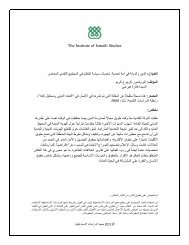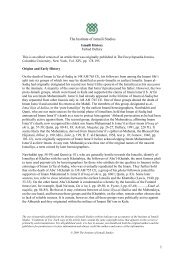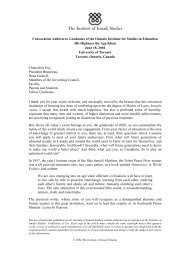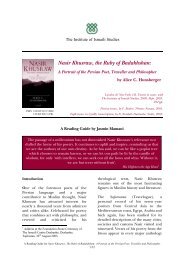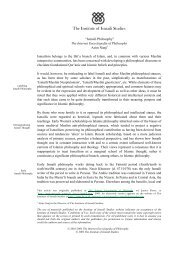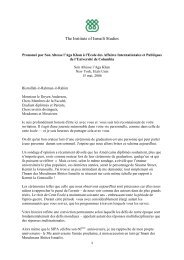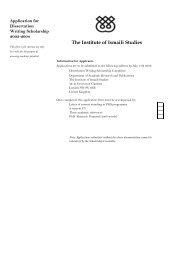BM-IIS Conference Pack.qxp - The Institute of Ismaili Studies
BM-IIS Conference Pack.qxp - The Institute of Ismaili Studies
BM-IIS Conference Pack.qxp - The Institute of Ismaili Studies
You also want an ePaper? Increase the reach of your titles
YUMPU automatically turns print PDFs into web optimized ePapers that Google loves.
<strong>BM</strong>-<strong>IIS</strong> <strong>Conference</strong> <strong>Pack</strong>.<strong>qxp</strong> 20/03/2009 14:12 Page 10<br />
OLEG GRABAR<br />
“Can We Identify Shi‘i Features in Art and Architecture?”<br />
<strong>The</strong> topic “Islamic art and Shi‘ism” is an invitation to explore a major issue in our<br />
understanding <strong>of</strong> the arts from Muslim lands and in fact a major issue in visual culture<br />
and art criticism, even in the history <strong>of</strong> art. <strong>The</strong> issue is whether there are specific forms<br />
or restricted subjects which are inspired by discrete features <strong>of</strong> religious movements or<br />
which become associated, for whatever reason, with followers <strong>of</strong> a religious movement.<br />
Such forms and subjects allow then or even compel the identification <strong>of</strong> whatever one<br />
sees with that particular group. From the standpoint <strong>of</strong> a theoretical analysis <strong>of</strong> the arts,<br />
the issue is fundamental, as it deals with the ways in which we interpret (or should<br />
interpret) what we see. An appropriate parallel is that <strong>of</strong> the use <strong>of</strong> language, as we can<br />
(or could) identify the age, education, and origins <strong>of</strong> individuals from hearing them<br />
speak, as accents, vocabulary, and grammar do reflect one’s own history or that <strong>of</strong> the<br />
family to which one belongs. Clothes and jewellery are another category <strong>of</strong> forms which<br />
can lead to similar results, identifying a person or a thing with a restricted religious or<br />
cultural entity. My remarks will be limited to a few examples <strong>of</strong> the kinds <strong>of</strong> research<br />
needed to answer the more fundamental queries I have raised.<br />
Oleg Grabar, Pr<strong>of</strong>essor Emeritus at the <strong>Institute</strong> for Advanced Study, Princeton, has had<br />
a pr<strong>of</strong>ound and far-reaching influence on the study <strong>of</strong> Islamic art and architecture. He<br />
received his PhD in Oriental Languages and Literatures and the History <strong>of</strong> Art (1955)<br />
from Princeton University at a time when there were few historians <strong>of</strong> Islamic art in the<br />
United States. Now, over fifty years on, Islamic art historians all over the world are<br />
indebted to Pr<strong>of</strong>essor Grabar’s influence as a teacher and for his numerous<br />
publications and public lectures. His extensive archaeological expeditions and research<br />
trips cover the vast expanse <strong>of</strong> the Islamic world in Africa, the Middle East, and Muslim<br />
Asia. His first teaching post was at the University <strong>of</strong> Michigan and in 1968 he accepted<br />
a post as Pr<strong>of</strong>essor <strong>of</strong> Fine Arts at Harvard University. He became the first Aga Khan<br />
Pr<strong>of</strong>essor <strong>of</strong> Islamic Art and Architecture when that chair was established at Harvard in<br />
1980 and joined the <strong>Institute</strong> for Advanced Study in the School <strong>of</strong> Historical <strong>Studies</strong> as<br />
Pr<strong>of</strong>essor Emeritus in 1990, where he has since devoted himself full-time to lecturing<br />
and research. Pr<strong>of</strong>essor Grabar has received several prestigious awards, including the<br />
Levi Della Vida award for distinguished scholarship in the field <strong>of</strong> Islamic <strong>Studies</strong> from<br />
the University <strong>of</strong> California and the Charles Lang Freer Medal for distinguished<br />
contribution to the knowledge and understanding <strong>of</strong> Oriental civilisations from the<br />
Smithsonian Institution. He has authored 18 books and more than 140 articles<br />
including: Epic Images and Contemporary History: <strong>The</strong> Illustrations <strong>of</strong> the Great Mongol<br />
Shahnama (Chicago and London 1982); <strong>The</strong> Mediation <strong>of</strong> Ornament (Princeton 1992);<br />
<strong>The</strong> Shape <strong>of</strong> the Holy: Early Islamic Jerusalem (Princeton 1996); Late Antiquity: A Guide to<br />
the Post-Classical World (with G. Bowersock and P. Brown, Cambridge 1999); <strong>The</strong> Art and<br />
Architecture <strong>of</strong> Islam 650-1250 (with R. Ettinghausen and M. Jenkins-Madina, New Haven<br />
and London 2001); Mostly Miniatures (Princeton 2002); and 83 articles gathered in four<br />
volumes under the title Constructing the Study <strong>of</strong> Islamic Art (London 2005-06).<br />
OLIVER LEAMAN<br />
Paper Paper Abstracts Abstracts and Academic Academic Biographies Biographies<br />
“Defining Shi‘i Art: Problems and Possibilities”<br />
Religious differences <strong>of</strong>ten lead to differences in art. How would one investigate<br />
whether there are any distinctive features in Shi‘i as compared with Sunni art? Is the<br />
notion <strong>of</strong> Shi‘i art at all legitimate? Religious groups certainly wish to project their<br />
ideas, and art is a useful way to do this. Such a process has two aspects, one relating to<br />
the matter <strong>of</strong> art and one to the form. <strong>The</strong> matter consists <strong>of</strong> the themes in an art work<br />
and the tradition on which it rests, and the Shi‘a might well be expected to favour<br />
certain ideas, narratives and even the representation <strong>of</strong> particular individuals in their



